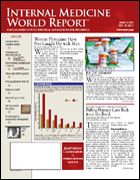Manufacturers Sneaking More Nicotine into Cigarettes
In Pursuit of Addictive Behaviors
CAMBRIDGE, Mass—A new analysis of nicotine yield from major brand-name cigarettes sold in Massachusetts from 1997 to 2005 has shown that manufacturers are progressively increasing the nicotine content, reported researchers at a recent meeting at Harvard University. Their findings show that smoke nicotine yield per cigarette increased by an average of 1.6% each year between 1997 and 2005, or by 11% between 1998 and 2005.
“Our findings call into serious question whether the tobacco industry has changed at all in its pursuit of addicting smokers since signing the Master Settlement Agreement of 1998 with the State Attorneys General,” said Gregory N. Connolly, DMD, MPH, director, Tobacco Control Research Program, Division of Public Health Practice, Harvard. “Our analysis shows that the companies have been secretly increasing the drug nicotine year by year in their cigarettes, without any warning to consumers, since the settlement.”
The new analysis, which confirmed the magnitude of the increase first reported by the Massachusetts Department of Health in August 2006, shows that:
• Manufacturers are not only intensifying the concentration of nicotine in the tobacco but are also modifying several design features of cigarettes to increase the number of puffs per cigarette. The end result is a product that is potentially more addictive
• Smoke nicotine yields were increased in the cigarettes made by each of the 4 major manufacturers (Brown & Williamson, Lorillard, Philip Morris, RJ Reynolds) and encompasses all major cigarette market categories, including mentholated, nonmentholated, full-flavor, light, and ultralight.
Although relatively minor changes in nicotine yield may not significantly affect the product’s addictive qualities, “nevertheless, the total nicotine dosing capability, the speed with which nicotine can be delivered, and the ease with which nicotine can be extracted are among the determinants of the addiction potential of the cigarette,” the researchers note.
“Cigarettes are finely-tuned drug delivery devices, designed to perpetuate a tobacco pandemic,” said Howard Koh, MD, MPH, former commissioner of public health for the Commonwealth of Massachusetts.
Beginning in 1997, state regulations have required an annual report to be filed with the Massachusetts Department of Public Health by all manufacturers of cigarettes sold in the state. The reported data include machine-based measures of nicotine yield, as well as measures of cigarette design related to nicotine delivery.
The discovery of an 11% increase in nicotine content confirms recent statements by the US District Court for the District of Columbia that manufacturers have the ability to manipulate addictive additives. “It underscores the need for continued surveillance of nicotine delivery in products created by an unregulated industry,” Dr Connolly said.
